Our driver will pick you up from the airport and transfer you to the hotel for overnight
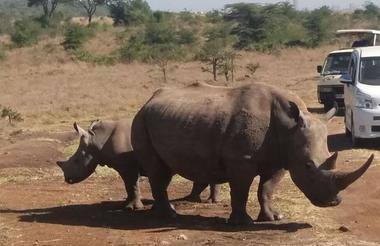
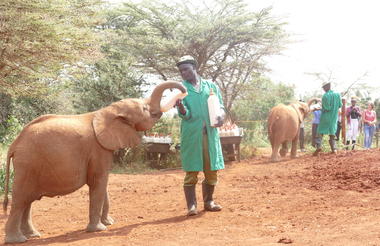

THINGS TO DO IN NAIROBI
Visit Nairobi National Park
Nairobi National Park lies only seven kilometers from the skyscrapers of Nairobi's city center. A haven for wildlife, the park is also a rhino sanctuary, which protects more than 50 of these critically endangered creatures.
In addition to the rhinos, you can see lions, gazelles, buffaloes, warthogs, cheetahs, zebras, giraffes, and ostriches, and more than 400 species of birds have been recorded in the wetlands.
David Sheldrick Wildlife Trust
At the main gates of Nairobi National Park, this orphan-elephant rescue and rehabilitation program is a must-see for animal lovers. Daphne Sheldrick founded the project in 1977 in memory of her late husband David, a former warden at Tsavo East National Park.
Giraffe Centre
At the Giraffe Centre, on the edge of Nairobi National Park, visitors can come face to face with endangered Rothschild's giraffes. This non-profit center lies on the grounds of the plush guesthouse, Giraffe Manor, and its main mission is to provide conservation education for children.
Karura Forest Reserve
Are you craving some solitude near the city? You're in luck. The beautiful Karura Forest is a cool, shady oasis just a few kilometers from the city center. This lush green space is actually one of the largest urban forests in the world, and you'll discover all kinds of things to see and do here. Hike to a multi-tiered 15-meter waterfall. Enjoy a picnic in the gardens. Watch monkeys clamber through the trees, or just sit quietly by Lily Lake and soak up the tranquility. Bike riding is also popular along the well-marked red-clay trails.
Karen Blixen Museum
One of Nairobi's top tourist attractions, the Karen Blixen Museum, at the foot of the Ngong Hills, is the former home of the famous namesake Out of Africa author. Karen Blixen, also known by her pen name, Isak Dinesen, lived in the house from 1917 to 1931, where she ran a coffee plantation.
Nairobi National Museum
The National Museum in Nairobi is an educational way to spend a few hours on a city stopover. The museum displays diverse cultural and natural history exhibits including more than 900 stuffed birds and mammals, fossils from Lake Turkana, ethnic displays from various Kenyan tribal groups, and exhibits of local art.
Bomas of Kenya
About 10 kilometers from Nairobi, Bomas of Kenya is a living museum celebrating the colorful tribes of Kenya. This is a great place to learn about the lifestyle, art, music, crafts, and culture of each tribe.
Kazuri Beads Factory Tour
Looking for some unique souvenirs and gifts for family and friends? The Kazuri Beads Factory is a great place to shop. Best of all, you're helping disadvantaged local women at the same time. Kazuri means "small and beautiful" in Swahili, and these shiny, brightly colored beads surely fit the bill.
Kenyatta International Conference Centre
Named for the Republic's First President, Jomo Kenyatta, the distinctive cylindrical Kenya International Conference Centre (KICC) offers breathtaking 360-degree views from its rooftop viewing deck.
Ngong Hills
"Ngong" means "knuckles" in Maasai, a fitting name since these beautiful pointed green hills resemble the back of a fist facing the sky. They are a popular place to visit close to Nairobi and provide a welcome respite from the city heat.
The Ngong Hills are the peaks of a ridge overlooking the Great Rift Valley, and many white settlers established their farms here in the early colonial days. Half-timbered houses and flowering gardens remain, but seem more suited to southern England than Africa.
Railway Museum
The Railway Museum in Nairobi celebrates the rich history of the railroad in Kenya and its impact on the nation's development. Among the museum's fascinating collections are train and ship models, photographs from the original construction of the Uganda Railway, railway magazines, maps and drawings, and a silver service set used on overnight trains to Mombasa.
National Archives
You'll find a little bit of everything about Kenya at this museum. Housed in the old Bank of India building, the National Archives spotlights Kenyan tribal culture, as well as the country's art, history, and politics.
After breakfast at the hotel, check out and begin drive to Amboseli through Nairobi. Arrival at the lodge in the afternoon for check in and lunch. Later proceed for a game drive in the park and return back for dinner and overnight
Accommodation at Amboseli Serena Camp (FB)
Drive time to Amboseli: 6hrs

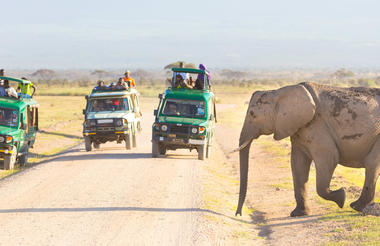

Guided Nature walk
The park is naturally rewarded with stunning vegetation, swamps, mammal species which can be encountered on your nature walk experience. Guided nature walk in Amboseli national park can be conducted around the park and on the observation hills. guided nature walk is the best way of adventuring the hidden treasures of the park since it is done on foot and also get a chance to have closer viewing of wild animals such as herds of elephants, zebras, giraffes, impalas, buffaloes among others as you listen to sweet melodies of birds singing as well as having a rewardable sightseeing with back drop of snowcapped Kilimanjaro and leave with wondrous experience once in life time.
Bird watching
Amboseli national park is an ideal place for birding since it is a home of over 400 bird species and they can be spotted along swamp areas, grasslands, acacia woodland such bird species to be encountered in here include; Greater flamingo, Lesser flamingo, Long toed lap claw, Rufous chatterer, Spike-heeled heron, Tavete golden weaver, vonder Dicken’s horn bills, Dickinson’s kestrel, Common redshank, African swamp hen, pangani long claw, Hartlaub’s bustard among others. The best time to do birding in Amboseli national park starts from May to June and October to December. You need to carry your binoculars to have clear sightseeing of bird species on far distances.
Cultural Tours
The park is surrounded with local community ‘’Maasai people’’ on your visit to Amboseli national park you can visit this local people in the afternoon time. And get to learn about their unique way of life such as their thrilling traditional dances as they jump up and down you can join them and leave with quite remarkable experience once in life time, unique clothing, you can as well as participate in the re-afforestation by planting seeds with them.
Wake up early morning for game drive and return back to the lodge for breakfast. Lunch to be taken at the lodge and then later in the afternoon proceed for a game drive in the park. Return back for dinner and overnight at the camp
Accommodation: Amboseli Serena Safari Lodge (FB)

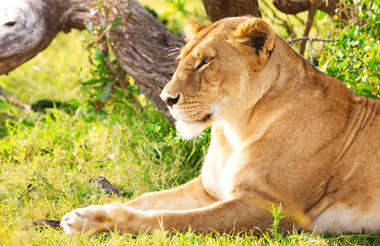
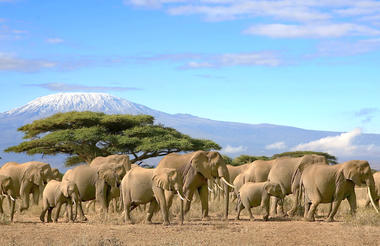
Wake up early morning for game drive and return back to the lodge for breakfast. check out and continue journey to Tsavo west national park where you will be spending the last 2 nights of the safari. Arrival in time for check in and lunch then later proceed for a game drive in the park. dinner and overnight at the lodge
Accommodation: Kilaguni Serena Lodge (FB)
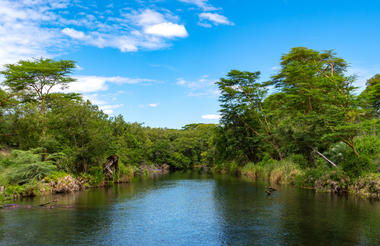
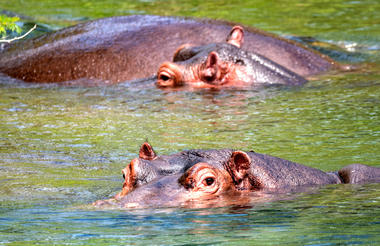
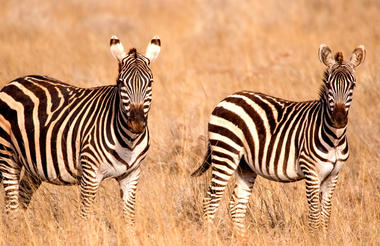
WHAT TO DO IN TSAVO
1) Beautiful scenery
Tsavo West is marked by a number of rocky outcrops and volcanic hills. Tsavo West National Park's landscape is dominated by giant baobabs reputed to live a thousand years. After the rain, Tsavo West National Park is showered with white and pink ipomea and acacia trees of white and pink blossom. The desert rose, somewhat like a miniature baobab, has pink flowers of striking beauty at almost any time of the year. On a clear day, the park offers lovely views of the snow-capped peaks of Mount Kilimanjaro.
2) Shetani lava flow
When entering Tsavo West through Chyulu gate, one of the first things you see in the park is Shetani lava flow. Shetani means ‘devil’ in Kiswahili. When the locals first saw ‘fire’ erupting and ‘flowing’ on the ground some 500 years ago, they believed that it was the devil himself emerging from the earth. The Shetani black lava flow is 8 km long, 1.6 km wide and 5 meters deep. The sight is quite special and spectacular.
3) Chaimu volcanic crater and lava field
Notice how the road color changes from red to black as you get closer to Chaimu. Chaimu crater, or “the devil's crater” in Kamba tribe language, is a tall rising hill clad in the bright black colour of the lava stones. You can climb this recent volcano as there is a path leading to the top. Climbing the hill is not easy as it is not stable and can be slippery.
4) Five sister’s hills
One more volcanic feature of Tsavo West is ‘Five Sisters,’ the five almost identical cone-shaped hills located in one area and resembling one another. The scenery is stunning – a low ridge of black lava outcrop, long luscious grass and conical hills that make the Five Sisters.
5) Mzima springs
Mzima Springs are replenished with two hundred and twenty million litres of crystal-clear water every day. It comes from the underground streams flowing from the nearby Chyulu Hills. Mzima in Swahili means ‘Life’. It attracts rich wildlife including elephants, hippos, crocodiles, gazelles, zebras and giraffes wandering around the banks through the thick acacias and raffia palms together with a large number of monkeys and birds. Mzima is also the main source of Mombasa's city water supply. There are well-marked nature trails, an observation platform and an underwater glass tank. You can take a walk guided by a ranger there.
6) Game Drives
Tsavo West offers magnificent game viewing. Thick vegetation makes it more difficult compared to more open parks, for example, the Masai Mara, but with some patience, visitors can see some of the big five along with a wide range of antelope species, hippos, and spectacular birdlife. Just make sure you have the best binoculars for your safari. The species I saw for the first time just in Tsavo after visiting Masai Mara and Amboseli were large African Eland antelopes, a family of the dick-dicks, the smallest antelopes in Africa and funny warthogs. Giraffes on the Tsavo hilly background looked especially attractive.
Practical information
Distance: Mtito Andei gate is located 240 km from Nairobi and 250km from Mombasa.
Other gates: Tsavo, Lake Jipe, Chyulu, Maktau, and Ziwani.
Getting there by air: There are several good airstrips for chartered aircraft at Chyulu, Mtito Andei, Tsavo, Jipe, Maktau, Kasigau and Ziwani gates.
Roads: The main access routes are through Chyulu Gate from Amboseli and Mtito Andei Gate from Nairobi.
The best time to visit: it is usually from May to October when the humidity and temperatures are relatively low. This time is also the tourist peak season in Tsavo and is ideal for game viewing.
Wake up early morning for game drive and return back to the lodge for breakfast. Lunch to be taken at the lodge and then later in the afternoon proceed for a game drive in the park. Return back for dinner and overnight at the camp
Accommodation: Kilaguni Serena Lodge (FB)
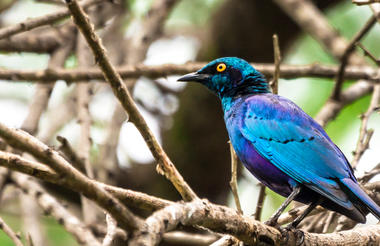


After breakfast, check out of the lodge and begin journey back to Nairobi. Arrival in the afternoon where the driver will transfer you back to your hotel for overnight or drop off at JKIA for your onward international flight.
Drive time to Nairobi: 4 hours




